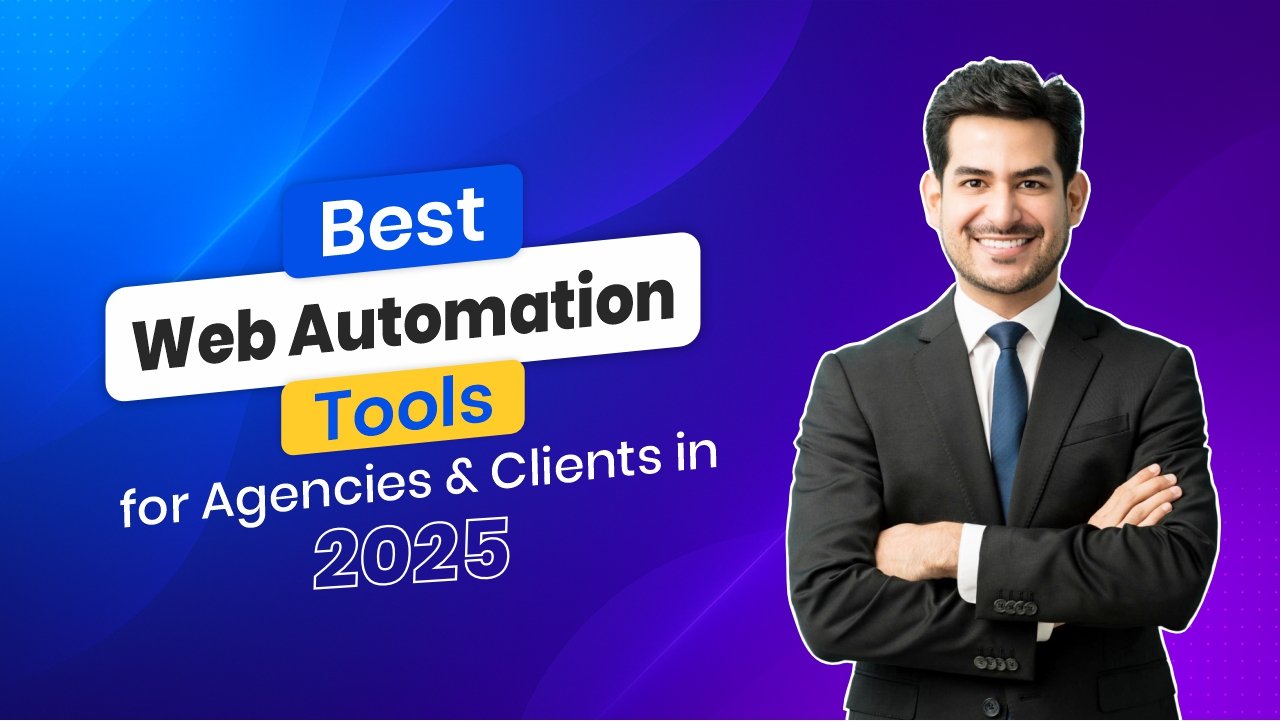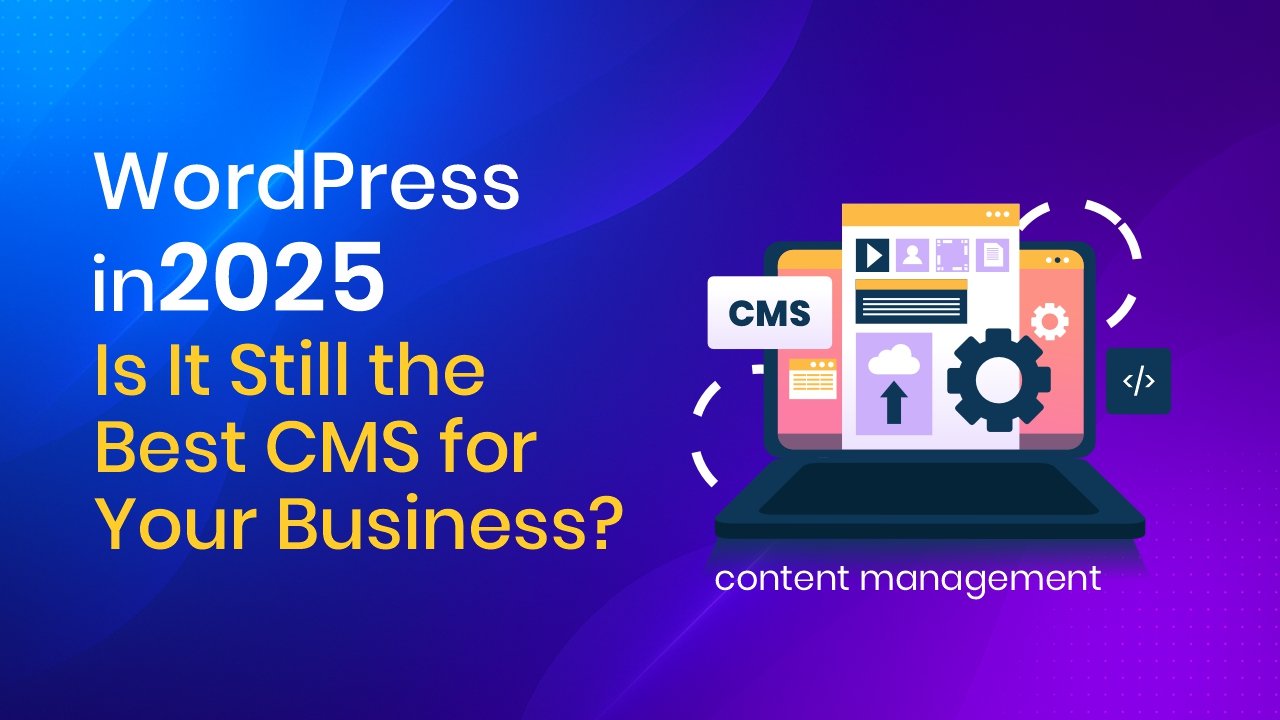Web Performance Tips for 2025 Lazy Loading, WebP & Code Splitting Are you a business owner in Raipur, Chhattisgarh, wondering why your website isn’t attracting as many local customers as you’d hoped? In the bustling digital landscape of our vibrant city, from the lanes of Sadar Bazaar to the new developments in Naya Raipur, a fast and responsive website isn’t just a luxury – it’s a necessity. Just as the flyovers ease traffic flow in our city, optimizing your website’s performance ensures a smooth journey for your users, directly impacting your visibility on Google. For any Raipur business aiming for the top 10 search results, especially when people search for “web development Raipur” or “local services Raipur,” understanding web performance in 2025 is paramount.web performance
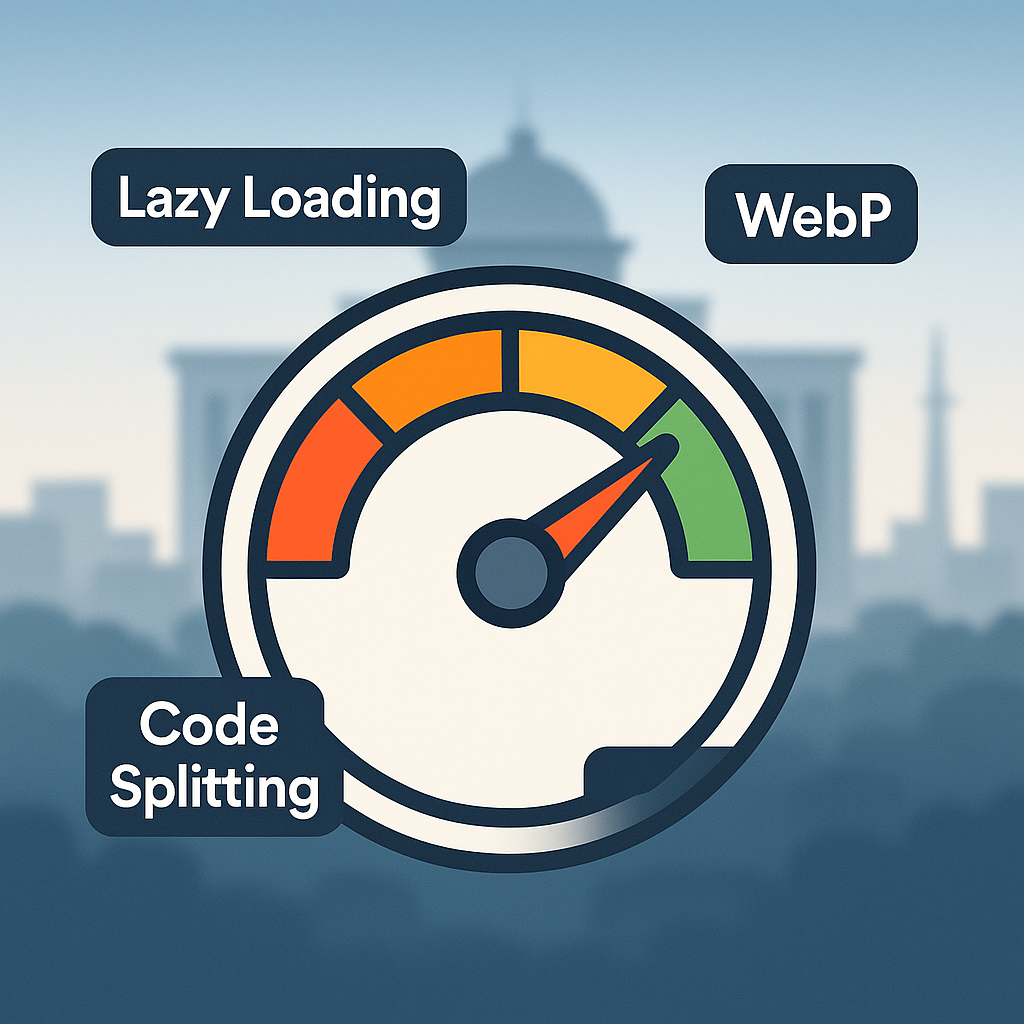
The Need for Speed: Why Web Performance Matters More Than Ever in 2025
The internet is faster, users are more impatient, and Google’s algorithms are smarter. In 2025, website speed is no longer just a technical detail; it’s a core component of your online success, particularly for businesses in competitive markets like Raipur. Google’s Core Web Vitals, which measure visual stability, loading speed, and interactivity, have cemented page experience as a critical ranking factor. A slow website means higher bounce rates, lower conversions, and, ultimately, a significant drop in your search engine rankings. For Raipur businesses, this translates directly to lost customers.
But how do you achieve this elusive speed? This comprehensive guide will walk you through three essential web performance strategies for 2025: Lazy Loading, WebP image format, and Code Splitting. Implementing these will not only delight your users but also give your website the edge it needs to rank on the first page of Google for “Raipur” keywords.
Lazy Loading: Delivering Content When It’s Needed
Imagine you’re walking through Marine Drive in Raipur, and every shop you pass immediately opens all its doors and turns on all its lights, even if you’re just looking at the fountain. That’s what happens when a website loads all its content at once. Lazy Loading is the smart alternative.
What is Lazy Loading?
Lazy Loading is an optimization technique where content (images, videos, or other media) is loaded only when it enters the user’s viewport. Instead of loading everything when the page first loads, only the visible content is loaded, significantly speeding up initial page load times. As the user scrolls down, more content is progressively loaded.
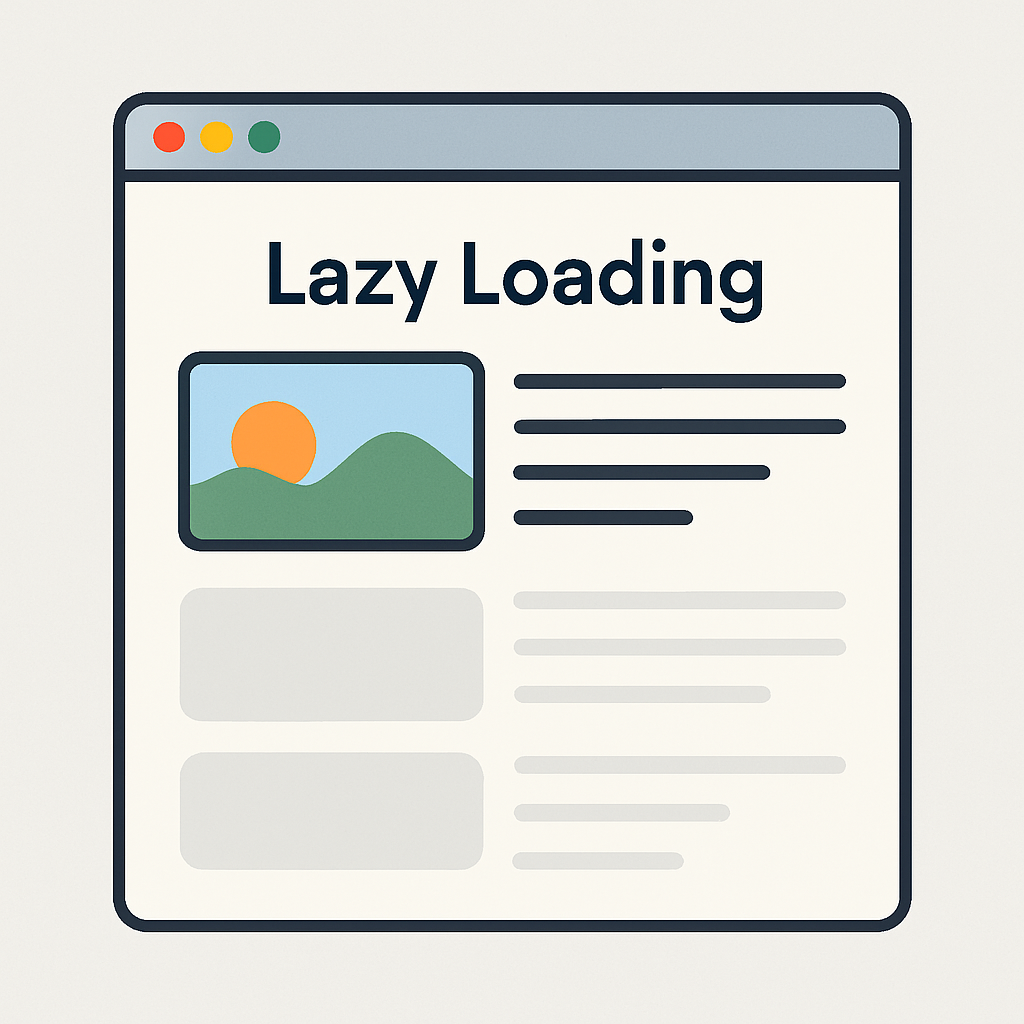
Why is it crucial for your Raipur website in 2025?
- Improved Initial Load Time: This is a major factor in Core Web Vitals (specifically Largest Contentful Paint – LCP). Faster initial loads mean users in Raipur get to your content quicker.
- Reduced Bandwidth Consumption: By only loading what’s necessary, you save bandwidth for both your server and your users, which is especially beneficial for mobile users in areas with slower internet connections.
- Enhanced User Experience: A fast, smooth loading experience keeps users engaged, reducing bounce rates and encouraging them to explore more of your Raipur business’s offerings.
- SEO Benefits: Google favors faster websites. Lazy Loading directly contributes to better page speed scores, which Google rewards with higher rankings.
How to Implement Lazy Loading :
If you’re using WordPress, implementing Lazy Loading is often straightforward. Many themes and plugins, including popular performance plugins, offer this feature out of the box. Rank Math itself integrates with various performance optimizations.
- WordPress 5.5+ Native Lazy Loading: WordPress now includes native lazy loading for images and iframes by default. This is a great starting point, but for more advanced control and other asset types, dedicated plugins are recommended.
- Performance Plugins: Plugins like WP Rocket, LiteSpeed Cache, and W3 Total Cache offer robust lazy loading options for images, videos, and even background images. They often integrate seamlessly with Rank Math for a comprehensive SEO and performance strategy.
- Manual Implementation (for developers): For custom development, you can implement lazy loading using JavaScript. The
loading="lazy"attribute for<img>and<iframe>tags is a modern, simple approach supported by most browsers.
WebP: The Next Generation of Image Compression
When you think of the vibrancy of a Gariyaband market or the intricate details of a Bastar art piece, images are essential for conveying that richness online. However, traditional image formats like JPEG and PNG can be heavy, slowing down your Raipur website. Enter WebP.
What is WebP?
WebP is an image format developed by Google that provides superior lossless and lossy compression for images on the web. It offers significantly smaller file sizes than traditional JPEG and PNG formats while maintaining comparable image quality.
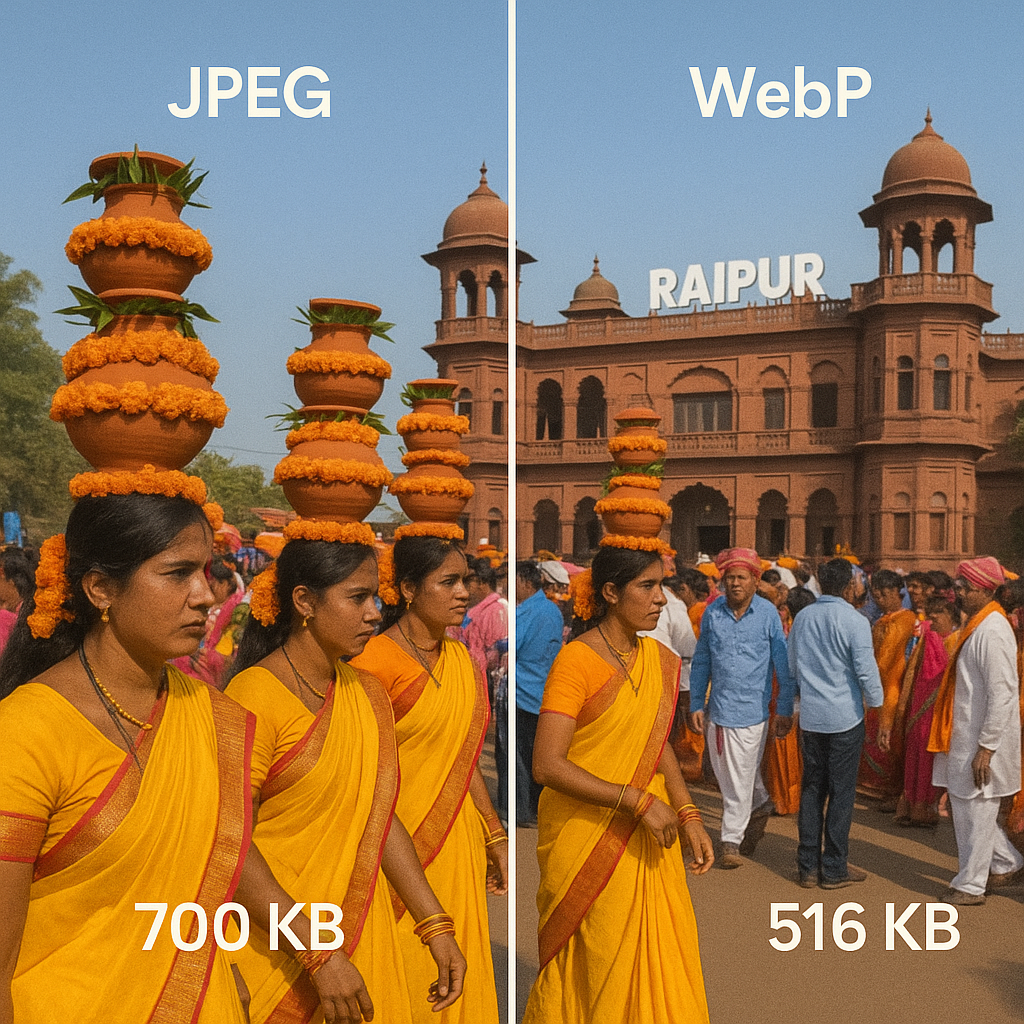
Why is it a game-changer for your Raipur website in 2025?
- Drastically Reduced File Sizes: Smaller image files mean faster loading times, which directly impacts your Largest Contentful Paint (LCP) score in Core Web Vitals.
- Improved Page Speed: Less data to download translates to a quicker user experience, especially for mobile users accessing your Raipur website on varying network conditions.
- Better Google Rankings: Google actively promotes WebP usage due to its performance benefits. Websites utilizing WebP are likely to receive a positive signal from search engines.
- Enhanced User Experience: Images load faster and smoother, creating a more visually appealing and enjoyable experience for your Raipur audience.
How to Convert and Serve WebP Images :
Converting to WebP is a critical step for any website, and WordPress users have excellent tools at their disposal.
Content Delivery Networks (CDNs): Many CDNs offer on-the-fly WebP conversion and delivery. If you’re using a CDN (highly recommended for global and even local reach for your Raipur business), check their WebP optimization features.
Image Optimization Plugins: Plugins like Smush, EWWW Image Optimizer, and Imagify can automatically convert your uploaded images to WebP format and serve them to compatible browsers. They often have settings to integrate with your existing media library.
Server-Level Configuration: If you have access to your server (e.g., via .htaccess for Apache or Nginx configuration), you can set up rules to automatically serve WebP versions of images if the browser supports it, falling back to original formats otherwise. This is highly efficient.
Code Splitting: Delivering Only What’s Necessary
Think of your website’s code as a large, multi-story building in Raipur. Do you need to open every single office and turn on all lights on every floor just for someone to enter the lobby? No. Code Splitting applies this logic to your website’s JavaScript, CSS, and other assets.
What is Code Splitting?
Code Splitting is a technique used to break down large bundles of JavaScript (and sometimes CSS) into smaller, more manageable “chunks” that can be loaded on demand. Instead of forcing the browser to download one massive file containing all your website’s code, only the code required for the initially viewed part of the page is loaded. Other parts are loaded asynchronously as the user interacts with the site or navigates to different sections.
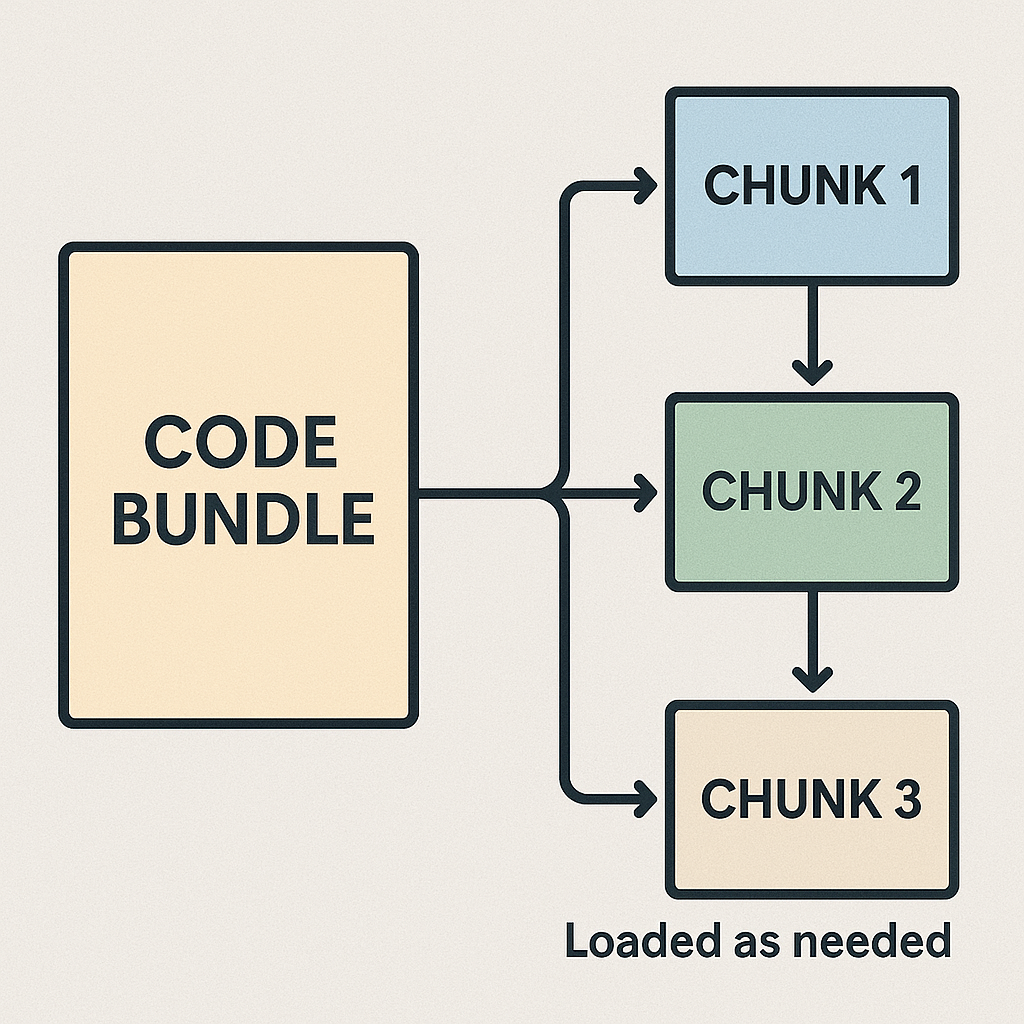
Why is it vital for your Raipur website’s performance in 2025?
- Reduced Initial Load Time: This significantly improves your First Contentful Paint (FCP) and Time to Interactive (TTI) metrics, as the browser has less code to parse and execute upfront.
- Improved Interactivity: By loading only essential code, your website becomes interactive much faster, preventing the frustrating “blank page” or unresponsive experience.
- Efficient Resource Utilization: You’re not making users download code they might never use, which is especially important for complex web applications or large e-commerce sites in Raipur.
- Better Cacheability: Smaller chunks of code are more likely to be cached individually by the browser, meaning repeat visits are even faster if only a small part of the code has changed.
How to Implement Code Splitting:
Code Splitting is typically implemented at the development level, usually with modern JavaScript frameworks and build tools.
- JavaScript Frameworks : These frameworks offer built-in support or straightforward patterns for code splitting (e.g., dynamic
import()in React,lazyandSuspensein React, route-based splitting in Vue Router). - Bundlers : Tools like Webpack are essential for configuring and automating code splitting. They can analyze your code and create separate bundles based on entry points, dynamic imports, or common dependencies.
- Route-Based Splitting: A common strategy is to split code based on different pages or routes of your website. When a user navigates to a new page, only the code specific to that page is loaded.
- Component-Based Splitting: For complex components that are not immediately visible (e.g., a modal, a rich text editor), you can load their code only when the user interacts with them.
While Rank Math won’t directly implement code splitting, a well-optimized WordPress setup with good theme and plugin choices often means that underlying frameworks and build processes already handle some level of this. For custom developed sites or highly interactive WordPress builds ensure your developers are leveraging these techniques.
Putting It All Together for Your Raipur SEO Success
Implementing Lazy Loading, WebP, and Code Splitting isn’t just about technical finesse; it’s about providing an exceptional user experience that Google recognizes and rewards. When a potential customer in Raipur searches for “best web design Raipur” or “local digital marketing,” a fast and fluid website instantly builds trust and professionalism.
These optimizations contribute significantly to your Core Web Vitals scores:
- Largest Contentful Paint (LCP): Lazy Loading and WebP dramatically reduce the time it takes for the largest content element on your page to become visible.
- First Input Delay (FID): Code Splitting ensures that the main thread is less busy parsing and executing JavaScript, leading to quicker responsiveness to user input.
- Cumulative Layout Shift (CLS): While not directly addressed by these three, a faster loading site with less content shifting due to late-loading elements often has better CLS.
By prioritizing these web performance tips for 2025, you’re not just making your website faster; you’re making it more competitive in the Raipur market.
Frequently Asked Questions :
Q1: How do Lazy Loading, WebP, and Code Splitting directly impact my Google ranking in Raipur?
A1: Google prioritizes user experience, and a fast website is a key part of that. Lazy Loading, WebP, and Code Splitting improve your site’s load speed and interactivity, which are measured by Core Web Vitals. Better Core Web Vitals scores directly influence your Google search ranking, helping your Raipur business appear higher in local search results.
Q2: Is it difficult to implement these web performance optimizations on a WordPress website?
A2: For WordPress users, implementing Lazy Loading and WebP is generally quite straightforward, often requiring just a few clicks within a good performance plugin. Code Splitting is more developer-centric but can be achieved with carefully chosen themes, plugins, and custom development best practices.
Q3: Will converting my images to WebP affect their quality?
A3: WebP offers superior compression while maintaining high visual quality. In most cases, users will not notice a difference in image quality, but they will certainly experience a faster loading website. It’s a win-win for your Raipur online presence!
Q4: What if my website is already performing well? Should I still implement these tips?
A4: Absolutely! Web performance is an ongoing process. As technology evolves and user expectations increase, continuously optimizing your site ensures you stay ahead of the curve and maintain your competitive edge in the Raipur market. Plus, even marginal gains can significantly impact large-scale websites.
Q5: Besides these three, what other web performance tips should I consider for 2025?
A5: Other vital tips include minimizing CSS and JavaScript, leveraging browser caching, using a Content Delivery Network (CDN), optimizing server response times, reducing server requests, and ensuring your hosting provider (ideally one with local Raipur servers if possible) is robust. Mobile-first design and accessibility are also crucial for 2025.
Ready to make your Raipur business shine online with a lightning-fast website? Don’t let slow loading times hold you back from connecting with your local audience. Contact https://webitof.com/contact/ today, your trusted web development and SEO experts in Raipur, to get a free website performance audit. Let’s optimize your digital presence and ensure your business is not just visible, but truly outstanding in 2025! We’re here to help Raipur businesses thrive https://webitof.com/.


